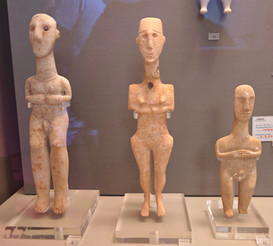Athens : The City of the Gods
- muse7699
- Sep 4
- 4 min read

Me at 15: Mom, I decided to take a Mythology class instead of Honors English next semester
Mom: Why, you should be reading the classics
Me: But these are the classics, Helen of Troy, Homers Odyssey, Hercules, Zeus, Athena, Hippocrates, Plato and Socrates.
I still remember the high school battles I had with my mom over what is considered the correct high school curriculum. I was fortunate to be able to go to a high school, and at a time, where I was able to choose nontraditional classes. I can't remember when I first learned about the gods and goddesses of Ancient Greece. But their stories have stayed with me, and I finally had the time to bring them to life in the city of the Gods - Athens

Acropolis. The best place to start any tour of Athens is at the Home of the Gods. Perched atop a rocky hill a majestic gateway to the world of ancient myths and legends. This monumental structure, built in the 5th century BC, is more than just an archaeological site but a tale of gods and heroes. A political, cultural and spiritual center at the heart of Athens.

At the heart of the Acropolis’ mythological background is the legendary contest between Athena, the goddess of wisdom and war, and Poseidon, the god of the sea, each vying to be the patron deity of the city. The story unfolds with Poseidon striking his mighty trident into the ground, causing a spring of saltwater to surge forth, Athena, however, presented an olive tree, a symbol of peace, prosperity, and resilience. The citizens of Athens, valuing the lasting, practical gifts of the olive tree over the transient spectacle of Poseidon’s saltwater spring, declared Athena the victor. Thus, Athena became the city’s patron and gave her name to it – Athens.




Ancient Agora - The Ancient Agora of Athens was the administrative, political, and commercial center. Where the great thinkers like Sophocles and Socrates, would meet and where ordinary citizens could come and interact with their peers, voice their concerns and trade their wares. It was where the concept of modern democracy was first practiced. The Panathenaic Way, starts here and winds its way up to the Acropolis. The Stoa of Attalos was a place for Athenians to meet, walk and do business. Wandering through the ruins you come across the Temple of Ares and the Altar of the 12 Gods. Atop a small hill resides the Temple of Hephaestus.

The Panathenaea was a multi-day ancient Greek festival held annually to celebrate the goddess, Athena. The festival consisted of various competitions and ceremonies, culminating with a religious procession that ended at the Acropolis. Every four years Athenians and non-Athenians gathered for a larger competition which included chariot races, boxing, wrestling, and pentathlon, as well as poetry and musical competitions. Winners were presented laurel wreaths from the olive tree. The precursor to the modern Olympic Games. Exploring the Panathenaic Stadium and Olympic Museum was one of the highlights of my weeklong stay in Athens.

It was 95 degrees outside at 11am, on its way to triple digits when I made my way to the Archeological Museum of Athens. As archeological sites are being excavated, vases, marble and bronze sculptures, jewelry, and tombstones are moved to the museum for all to see. I used Rick Steves audio guide as I wandered from room to room. Starting with the mysterious figurines carved by the Cycladic people to the Mycenaeans, including the mask of Agamemnon to the Hellenistic Age.
When we think of Ancient Greek civilization we think of the Classical period (500 BCE - 323 BCE). Marked by the rise of democracy, the Persian wars and the Peloponnesian War. When Homer wrote the Iliad and the Odyssey. When Socrates and Plato orated in the Agora and when temples dedicated to the ancient gods and goddesses were erected.

But go back 1000 years and you enter the age of the Mycenaeans. Mycenaeans were the first “Greeks”. Their influence and power are seen with grand citadels, palaces and royal tombs. Unearthed artifacts speak of a people with strong cultural presence, a centralized administrative system with a king and strong commercial ties to the rest of the Bronze Age Mediterranean centers. They worshipped earth, life and death deities. Precursors to Zeus, Hades and Dionysus. History of Greece: Mycenaean Greece

Many of the legends of Ancient Greece have their origins in this period. Heroic deeds like the dynasty of Atreids, the labors of Hercules, the Trojan war, and Agamemnon’s tragic life and death, are rooted in the Mycenaean period. It's an easy day trip to Mycenae to explore the archeological site. You enter the site through the Lion Gate and wander through various grave circles to the royal palace. Mycenae’s strategic location allowed it to control commerce among various Aegean islands and the mainland. In a little over a hundred years, it became one of the richest and most powerful civilizations of its time.
In part 2 - I visit two of the most important sites dedicated to the God Apollo - Delphi and Delos.








































Comments